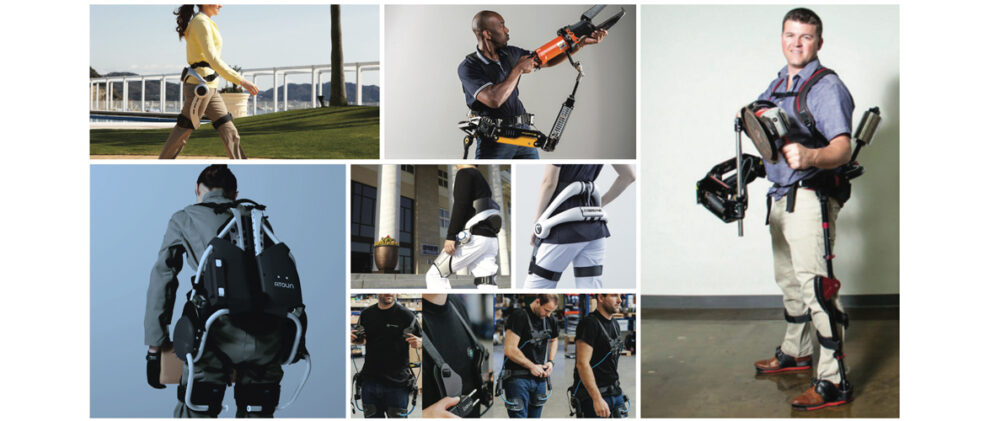The Wearable Robotics Association Standards and Education Committee is proud to publish its first white paper: Hip Exoskeleton Market – Review of Lift Assist Wearables. In just a few years, hip exoskeletons for movement assistance and work have gone from being virtually unknown to being sold and used around the globe.
But to the untrained eye, hip exoskeletons can be difficult to distinguish from one another. Which exos are commercially available and which are just research prototypes? What are these devices good for and what steps are being taken to standardize their description and evaluation? These and many other questions are answered by the authors of the Hip Exoskeleton Market – Review of Lift Assist Wearables white paper:
- Tom Sugar – Arizona State University, Wearable Robotics Association, SpringActive, Inc.
- Jan Veneman – Tecnalia Research and Innovation, COST Action CA16116: Wearable Robots
- Conrad Hochberg – CYBERDYNE, Inc.
- Mohammad S. Shourijeh – Rice University
- Arron Acosta – Rise Robotics
- Rita Vazquez-Torres – New Stone Soup VT, LLC
- Bobby Marinov – Exoskeleton Report
- Cota Nabeshima – Octa Robotics
And contributor:
- Roger Bostelman – National Institute of Standards and Technology, NIST
The WearRA white paper was written over a period of half a year and includes sections on current best practices, applications, categorization of hip exoskeletons, an overview of thirteen commercially available devices and those that are still prototypes. Because this was a collective effort from organizations from three different continents, this white paper includes more hip exoskeletons in one place than any previously published document in the public domain.
At nine pages, the hip exoskeleton is a short white paper. The WearRA committee made a decision that while more information would always be useful, it is better to have a finished publication that can help buyers and regulators get a feel for the industry as it stands now. The current intent is for future versions and revisions of the white paper to include significantly more information.
You can access the white paper on hip exoskeletons through the Wearable Robotics Association website: http://www.wearablerobotics.com/industry-news-education/








Where can the walk assist device helpful in climbing about 60 steps to an apartment blaock be found and estimated cost.pl
Great question! Regrettably, the answer is a tentative “no.” There are a few companies that are focusing exclusively on exoskeletons to assist with climbing stairs. The companies are aware that stairs is the #1 enemy to mobility independence. There is at least one company in the US that is currently in stealth-mode that has stair-assist as their priority. ATOUN recently published on YouTube a video for walking assistance.
At the moment, I don’t know of a wearable robot that can assist with stair climbing but the issue has been identified and prototypes are being developed. Stay tuned!
We all chose the wrong path, and the wrong way to create a true exoskeleton. We depend too much on principles and theories, and try to create a robot outfit and call it an exoskeleton or powered suit.
It is NOT, not a true exoskeleton, because it depends too much on the robot industry instead of the natural.
So, what is true exoskeleton?
With you, I really do not know. With me, it’s definitely another exoskeleton thing here, it’s more like a bike than a robot.
Perhaps the only difference here is how we perceive things.
I think you are more correct than you realize. What is an exoskeleton doesn’t matter as everyone perceives it as being something different? However, it will be much easier if there is a common reference frame that can make discussions and entry into the technology easier.
Mi esposa tiene 55 años y problemas para caminar por artritis y artrosis por problemas en rodillas y metatarzo. Como puedo comprar uno de estos equipos que la ayuden a caminar ?. Gracias
Dear Juan, sorry to hear about the walking problems your wife is having due to her arthritis and osteoarthritis at the knees. Many of the powered knee exoskeletons could potentially be helpful. A there are a few distributors at this point, it is best to contact companies individually.
My son has muscular dystrophy. He is 27 years old. He walks with support short distances. Can he be helped with it. How to avail of it and what would the cost be. Please inform.
Dear Manpreet, at the moment there are few gait exoskeletons for personal use and it costs upwards of $80,000 when you factor in training and maintenance. With more interest and investments in the exo industry the cost will go down, but for now, I am assuming that is of little consolation.
My father had his hips replaced in early 2000 and is now due for a revision – but due to his age and breathing surgery is a high risk option. He is able to walk with a walking frame and is not in any pain currently – but suffers from instability / weakness in the hips. I am exploring potential exoskeleton options that could provide him with the required support and no longer require him to consider surgery. I would be grateful if someone can guide me. I am based in London.
Hello Hassan. There really aren’t any buyer’s guides on exoskeletons, and the hip is a tricky joint. The EU did a program on hip-only powered medical exoskeletons a few years back, but I am not 100% sure what the outcome was. The closest thing that comes to mind is the Honda stride assist, unfortunately, I am not sure when and where it will become available.